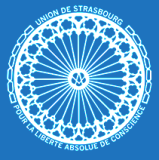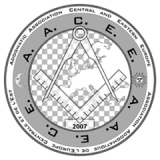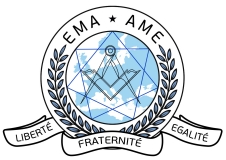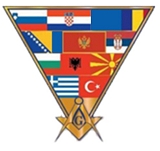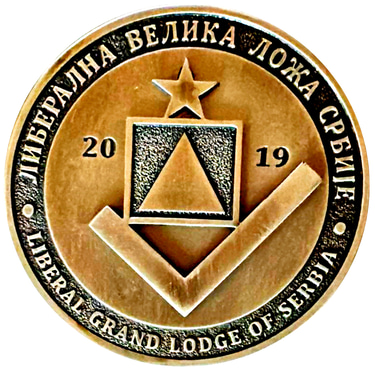Freemasonry
Freemasonry is often defined as “a special system of moral lessons, veiled in allegory and illustrated by symbols. According to the definition of the United Grand Lodge of England, the oldest masonic jurisdiction in the world, Freemasonry is "a secular, fraternal and benevolent organization imparting instruction in the lessons of morality and self-knowledge through participation in a progression of allegorical plays in two acts." For Freemasons in the United States of America, "Freemasonry is dedicated to the brotherhood of men under the fatherhood of God" and it is "the world's oldest philanthropic organization dedicated to humanitarian work in society."
For liberal freemasons, according to the definition of the Grand Orient of France, the originator of the ideas of liberal freemasonry and the largest jurisdiction in continental Europe, "freemasonry is an initiation and philanthropic society open to men and women of good will and high ethical standards." Their methods represent an approach to self-improvement and self-realization through universal symbols.”
The first article of the Constitution of the Grand Orient of France states: "Freemasonry, which is essentially a philanthropic, philosophical and progressive institution, aims to search for truth, study ethics and practice mutual support." It works for the material and moral improvement of humanity,towards intellectual and social improvement."
According to the well-known researcher of esoteric teachings, Jan A. M. Snoek: "The best way to explain Freemasonry is by what it is not, not by what it is."
The symbolism of Freemasonry is mainly, but not exclusively, drawn from the tools of master masons - square and compasses, levels and plumb, hammers and chisels, and others, with the use of which a rough hewn stone is converted through persistent work to a smooth and perfect hewn stone, which is then symbolically used for spiritual, moral, and intellectual self-building. Moral lessons are attributed to each of these tools as well as the construction process. The meaning of symbolism is taught and explored through ritual, and in lectures and articles by individual Masons that offer personal insights and opinions. Because of the symbolic use of masons' tools for their abstract and speculative "works", freemasonry is called "speculative" in contrast to the so-called "operative" masonry of the master builders, who founded lodges of operative masons all over Europe since the early Middle Ages.
The basic unit of masonic organization is called "Lodge", it consists of a certain number of "Brothers" or "Sisters" - as the members of the Lodge call themselves, and they meet and work in the "Temple" - a room specially decorated for the performance of Masonic rituals. The lodge is managed by the "Worshipful" Master with the help of his deputies and other "officers" of the lodge. The Master and officers of the Lodge are elected by secret ballot of all full members of the Lodge to lead the Lodge for a specified period of time of one or two years. The work of the lodge is not secret, but it is closed to the public and can only be attended by members of the given lodge and other visiting freemasons after strict verification of their affiliation with a legal Masonic organization.
Permission for the establishment and operation of the Lodge is given by the Grand Lodge under whose "protection" the Lodge operates. In turn, a Grand Lodge or "Grand Orient" as it is called in certain jurisdictions, can only exist if it is founded by at least three already legally existing Lodges. This indicates the process of expansion and growth of Freemasonry where one already existing Grand Lodge from one jurisdiction creates three new Lodges in another territory, to then cede them for the purposes of creating a new Grand Lodge in that other territory, whereby the already existing Grand Lodge issues permission ("Patent") for the work of the new Grand Lodge. The work of the Grand Lodge is managed by the "Most Worshipful" Grand Master with the help of deputies and grand officers, and in accordance with the valid legislative documents and regulations of the given obedience. The Grand Master and Grand Officers are elected and appointed by secret ballot by the General Assembly of the Grand Lodge, which is also the supreme legislative body of the obedience, and usually consists of delegates and Masters of the respective Lodges.
Formally, Grand Lodges are organizations of citizens, legally registered and established according to all valid regulations of the state in whose territory they are located. Admission to a Freemason's lodge is a complex process where those who apply for membership go through a months-long "investigation" of their character and moral views, political convictions and attitudes on social issues, as well as their motives for accessing membership. After the potentially positive decision of the "investigative commission", the application is sent to the vote of the Lodge, where the admission of the candidate to membership is decided by secret vote of all full members of the lodge.
All Freemasons begin their journey into the "craft" by being ritually "initiated" into the degree of "Apprentice," the first of three progressive degrees of "symbolic" or "blue" Freemasonry, as Grand Lodge-sponsored Freemasonry is otherwise called. As an Apprentice, a Freemason is taught the Masonic symbols of this degree of Freemasonry, their meanings and philosophy. He is also entrusted with the handle, password, and insignia of this degree so that he may "prove" himself to other Masons as an "Apprentice" and be "recognized" as such. After a certain period of time, usually a year spent studying and contemplating the moral lessons of this degree, the Apprentice ritually "transitions" into the degree of "Fellowcraft." Using the same methodology as in the degree of Apprentice, the Fellowcraft here enriches his knowledge and experience for a certain period of time, after which, after the vote of the members of the Lodge, he is allowed to be ritually "elevated" to the degree of "Master." As a Master, the freemason finally becomes a full member of the lodge with the right to vote and to be elected to various positions in the administration and work of the Lodge.
The rituals of the three degrees of Freemasonry are impressive and dramatic allegorical ceremonies that also contain explanatory lectures and are based on the biblical legend of the building of King Solomon's temple and the death of the master builder, Hiram Abif. Although there are many different versions of these rituals, with different script layouts and versions of the Hiram legend, each version is recognizable to any Mason of any allegiance.
According to its conceptual content, freemasonry is a practical philosophical system in which freemasons implement the results of abstract (ritual) work for: their own improvement, the general improvement of their surroundings and a better understanding of the reality that surrounds them. Through the symbolic use of construction tools, they practice logic, norms of ethics and principles of aesthetics. By means of scenography and choreography of their rites and rituals, they enter the fields of metaphysics and psychology. By means of scenarios of different degrees, they are involved in epistemology. It could be said that the difference between the traditional concept of philosophy and freemasonry lies in their positioning according to the object of research. While traditional philosophy speculates about the existing conditions of our realities, Freemasonry creates different conditions in the closed environment of the temple room, in order to actively change our understanding and our attitude, all in the belief that this will lead to personal progress and the acquisition of absolute knowledge.
The role of symbols in Freemasonry is to enable us to perceive on a different (higher) level, to transcend the material plane and consciousness and concentrate on the spiritual and unconscious. In other words, only if we are able to understand the deeper meanings of our thoughts and actions, we can use their qualities for our own spiritual and mental growth. Most modern theories about the meaning of symbols are inspired by the work of Carl Gustav Jung. He believed that symbols play an important role in the processes that affect every aspect of human mental or physical activities. According to Jung, all human beings are born with "instinctive predispositions" for the qualities that make us human, such as truth, justice, wisdom, mercy, love, and others. These "schemas" or "archetypes", as he calls them, are hidden deep within our subconscious being, but can be triggered to appear in consciousness in the form of symbols.
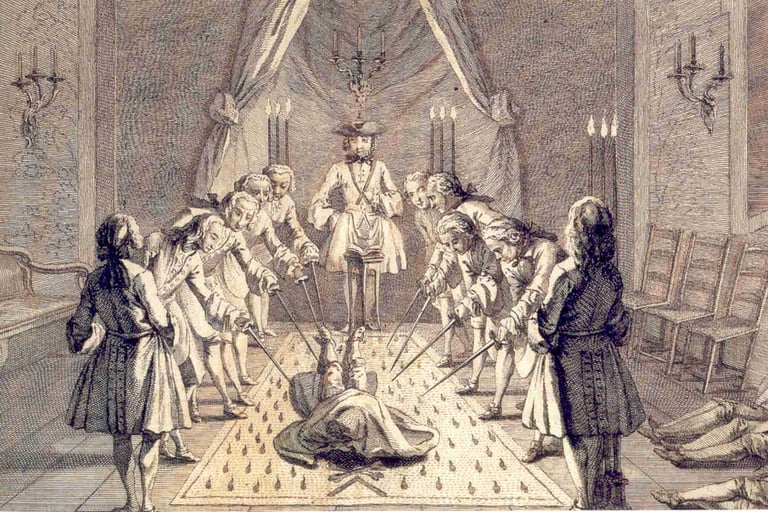

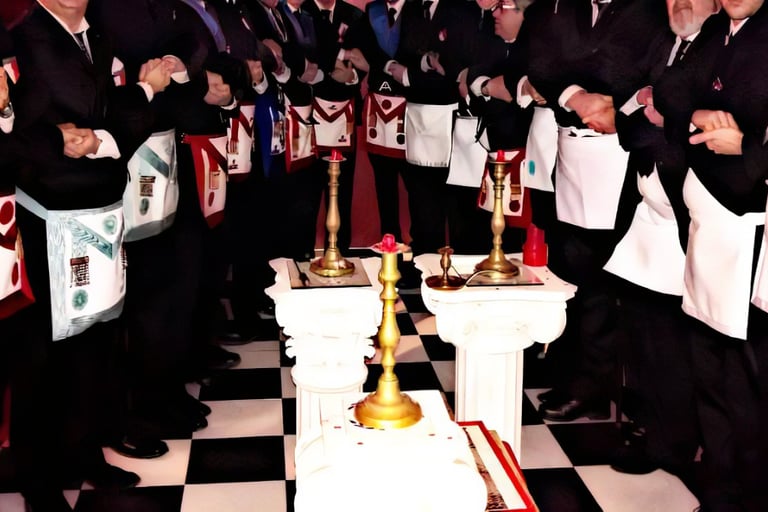

Masonic Initiation ( French gravure XVIII century)
Masonic Chain of Union
Connect
office@lvls.org.rs
Liberal Grand Lodge of Serbia - All rights reserved 2023
Subscribe to our newsletter
sekretarijat@lvls.org.rs
